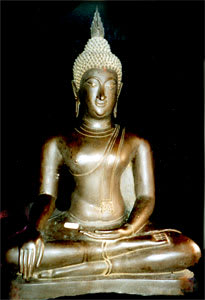Rattanakosin Bronze Sculpture of the Buddha Seated in the Dhyanasana Position, 17th Century CE - 18th Century CE
Bronze
28.375 x 43.25
X.0248
After the destruction of Ayutthaya in 1767 by the Burmese, King Tak Sin the Great drove out the invaders and reunified the country, establishing a new capital at Thonburi, a...
After the destruction of Ayutthaya in 1767 by the Burmese, King Tak Sin the Great drove out the invaders and reunified the country, establishing a new capital at Thonburi, a strategic river port town at the mouth of the Chao Phraya River. After Tak Sin was deposed, Thong Duang was chosen as king, known as Rama I, establishing the Chakri Dynasty which continues to reign over Thailand to this day. He moved the capital across the banks of the Chao Phraya River to its present location of Bangkok. The art of this period is known as the Rattanakosin style, although it is also referred to as the Bangkok style. Naturally, Rattanakosin art carried on many of the traditions of the Ayutthayan style, thereby establishing a link with the past.
The historical figure, Buddha Gautama Sakyamuni is the Buddha of compassion who, having achieved the highest evolutionary perfection, turns suffering into happiness for all living beings. Born around 560 B.C. somewhere between the hills of south Nepal and the Rapti river, his father was a Raja who ruled over the northeastern province of India, the district including the holy Ganges River. The young prince was married to Yashoda when he was about 17 years old and together they had a son named Rahula. At the age of 29, he left his life of luxury, as he felt compelled to purify his body and make it an instrument of the mind by ridding himself of earthly impulses and temptations.
This gorgeous bronze Buddha is seated in the dhyanasana position high upon a tiered base. With his hands, the Buddha forms the bhumisparsa mudra, which can be literally translated as the “gesture of touching the earth” in which the Buddha touches the ground in order to call on the earth to witness his enlightenment. Calm and serene, he looks downwards with half closed eyes. The Buddha’s distinctive tightly curled hairstyle is typical of Thai representations. A flame of enlightenment rises from the top of his ushnisa, a bump symbolic of the Buddha’s infinite wisdom. The sculptor has masterfully molded the subtle folds of fat around his neck, again indicative of the spiritual fullness and inner peace embodied by the Buddha. Overall, this exquisite sculpture beautifully memorializes one of history greatest holy figures.
The historical figure, Buddha Gautama Sakyamuni is the Buddha of compassion who, having achieved the highest evolutionary perfection, turns suffering into happiness for all living beings. Born around 560 B.C. somewhere between the hills of south Nepal and the Rapti river, his father was a Raja who ruled over the northeastern province of India, the district including the holy Ganges River. The young prince was married to Yashoda when he was about 17 years old and together they had a son named Rahula. At the age of 29, he left his life of luxury, as he felt compelled to purify his body and make it an instrument of the mind by ridding himself of earthly impulses and temptations.
This gorgeous bronze Buddha is seated in the dhyanasana position high upon a tiered base. With his hands, the Buddha forms the bhumisparsa mudra, which can be literally translated as the “gesture of touching the earth” in which the Buddha touches the ground in order to call on the earth to witness his enlightenment. Calm and serene, he looks downwards with half closed eyes. The Buddha’s distinctive tightly curled hairstyle is typical of Thai representations. A flame of enlightenment rises from the top of his ushnisa, a bump symbolic of the Buddha’s infinite wisdom. The sculptor has masterfully molded the subtle folds of fat around his neck, again indicative of the spiritual fullness and inner peace embodied by the Buddha. Overall, this exquisite sculpture beautifully memorializes one of history greatest holy figures.



